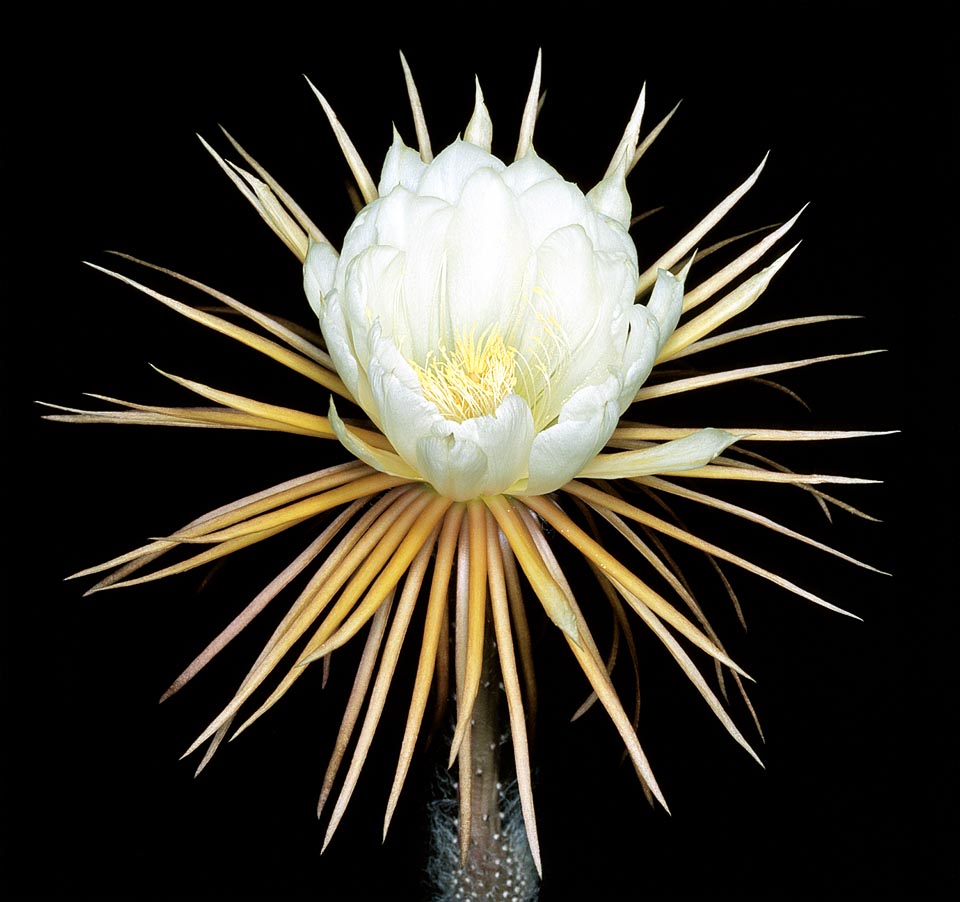Family : Cactaceae

Text © Pietro Puccio

English translation by Mario Beltramini
The Selenicereus pteranthus (Link & Otto) Britton & Rose (1909) is native to the tropical forests of Mexico (states of Chiapas, Tabasco and Veracruz).
The name of the genus is the combination of the name “Selene”, the Goddess of the Moon in the Greek mythology, and the name of the genus Cereus, with reference to the night blossoming; the name of the species is the combination of the Greek words “pteron” = wing, feather, and “anthos” = flower, of unclear reference.
Common names: “king of the night”, “pitahaya real”, “princess of the night”, “snake cactus” (English); “regina della notte” (Italian); “dama-da-noite”, “princesa da noite” (Portuguese); “flor de la noche”, “pitayita-nocturna”, “princesa de la noche” (Spanish); “Prinzessin der Nacht” (German).
Terrestrial or epiphytic plant, climbing or hanging, with bluish green to purple stems, long up to 3 m and a diameter of 3-5 cm with several aerial roots. It has 4-6 ribs with elliptic, 2-3 mm long, areolas, and spaced 2-2,5 cm, provided with 1-5, conical and 1-3 mm long, thorns. The flowers are funnel-shaped, odorous, up to 30 cm long with a diameter of 20-25 cm; the outer tepals are thin, linear, 5-12 cm long, of a brown or purple colour; the inner ones are white, oblong spatulate with sharp apex, about 12 cm long and 3-4 cm broad. Ovary and tube have reddish scales and areolas with several white long thin and soft thorns.

In the Mexican tropical forests, Selenicereus pteranthus creeps and climbs, like a snake, with 3-5 cm stems that easily reach 3 m, supported by several aerial roots. Showy night 20-25 cm flowers. Has good resistance to dry cold and is then often used by collectors as rootstock. It easily reproduces by seed and by stem portions © G. Mazza
The fruits are spherical, 5-7 cm of diameter, red, covered by about 1 cm long thin thorns, of yellow colour and long white hair, and contain several black seeds. It easily reproduces by seed and by stem portions, which has favoured its diffusion, so much to naturalize in some areas and become a pest.
It is one of the most appreciated among the night blossoming Cacti due to the size of the flowers and, in particular in the tropical and subtropical areas, due to the almost continuous blossoming. Even if it bears the full sun, it prefers slightly shaded positions, or with filtered sun light, and particularly draining substrata which can be formed for about the 50% of earth rich in humus and for the rest by siliceous coarse sand. During the vegetative period it needs a high ambient and soil humidity, but without water stagnations.
It is somewhat resistant to the dry cold, as it can stand, for short time, temperatures as low as -3/-4 °C, but it is better not to expose it to temperatures lower than +5 °C; therefore, in the areas where the climate doesn’t allow its open air cultivation, it is to be sheltered in winter in a very luminous and dry place, with temperatures around the 10 °C; this resting time is useful for a good blossoming. It is one of the plants utilized by collectors as rootstock.
Synonyms: Cereus pteranthus Link ex A. Dietr. (1834); Cereus nycticalus Link ex A. Dietr. (1834); Selenicereus nycticalus (Link ex A. Dietr.) W.T. Marshall (1941).
